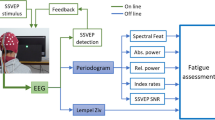Summary
We describe a frontal EEG potential which begins 25–35 ms before intentional saccadic eye movement. It consists of a 15–20 μvolt monophasic positive waveform with peak during or just after movement, and returns to EEG baseline 150–200 ms after its onset. The waveform is largest at a midline position just anterior to FZ (10–20 system), is independent of visual input such as fixation guides, and is not related to saccade direction or amplitude. The potential is difficult to observe in some subjects and is independent of the “pre-saccadic spike potential”. It may be related to the discharge of single cortical neurons that signal the initiation of saccadic movements, but not their exact metrics; a possible generator is the supplementary eye fields of the dorsomedial prefrontal cortex.
Similar content being viewed by others
References
Armington JC (1978) Potentials that precede small saccades. In: Armington JC, Krauskopf J, Woolen BR (eds) Visual psychophysics and physiology. Academic Press, New York, pp 363–372
Balaban CD, Weinstein JM (1985) The pre-saccadic spike potential: influences of a visual target, saccade direction, electrode laterality and instructions to perform saccades. Brain Res 347: 49–57
Becker W, Hoehne O, Iwase K, Kornhuber HH (1972) Bereitschaftpotential, premotorische Positivierung und andere Hirnpotentiale bei sakkadischen Augenbewegungen. Vision Res 12: 421–436
Brooks BA (1977) Vision and visual evoked potentials during saccadic eye movements. In: JE Desmedt (ed) Visual evoked potentials in man: new developments. Clarendon Press, Oxford, pp 301–313
Bruce CJ, Goldberg ME (1985) Primate frontal eye fields. I. Single neurons discharging before saccades. J Neurophysiol 53: 603–635
Fox PT, Fox JM, Raichle ME, Burde RM (1985) The role of cerebral cortex in the generation of voluntary saccades: a positron emission tomographic study. J Neurophysiol 54: 348–369
Goldberg G (1985) Supplementary motor area structure and function: review and hypothesis. Behav Brain Sci 8: 567–616
Goldberg ME, Bruce CJ (1990) Primate frontal eye fields. III. Maintenance of a spatially accurate saccade signal. J Neurophysiol 64: 489–508
Goldberg ME, Bruce CJ (1986) The role of the arcuate frontal eye fields in the generation of saccadic eye movements. In: Freund HJ, Büttner U, Cohen B, Noth J (eds) Progress in Brain Research, Vol 64. Elsevier, New York, pp 143–154
Hening W, Favilla M, Ghez C (1988) Trajectory control in targeted force impulses. V. Gradual specification of response amplitude. Exp Brain Res 71: 116–128
Kornhuber HH, Deecke L (1964) Hirnpotentialänderungen beim Menschen vor und nach Willkürbewegungen, dargestellt mit Magnetbandspeicherung und Rückwärtsanalyse. Pflügers Arch 284: 1–17
Kurtzberg D, Vaughan HG (1982) Topographic analysis of human cortical potentials preceding self-initiated and visually triggered saccades. Brain Res 243: 1–9
Moster ML, Goldberg G (1990) Topography of scalp potentials preceding self-initiated saccades. Neurology 40: 644–648
Nativ A, Weinstein JM, Rosas-Ramos R (1990) Human pre-saccadic spike potentials. Invest Ophthal Vis Sci 31: 1923–1928
Ohnishi T (1987) Studies on the dynamic topography of premotor potentials preceding visually guided saccadic eye movements 1. Methodological study and reproducibility of each component of the pre-saccadic potentials. Acta Soc Ophthalmologica Jpn 91: 509–518
Regan D (1989) Human brain electrophysiology, Elsevier, New York, pp 217–224
Riemslag FCC, Vander Heijde GL, Van Dongen M, Ottenhoff F (1988) On the origin of the presaccadic spike potential. EEG Clin Neurophys 70: 281–287
Schlag J, Schlag-Rey M (1987) Evidence for a supplementary eye field. J Neurophysiol 57: 179–200
Shibasaki H, Barrett G, Halliday E, Halliday AM (1980) Components of the movement-related cortical potentials and their scalp topography. EEG Clin Neurophys 49: 213–226
Thickbroom GW, Mastaglia FL (1985a) Cerebral events preceding self-paced and visually triggered saccades: a study of pre-saccadic potentials. Electroenceph Clin Neurophysiol 62: 277–289
Thickbroom GW, Mastaglia FL (1985b) Presaccadic “spike” potential: investigation of topography and source. Brain Res 339: 271–280
Thickbroom GW, Mastaglia FL (1986) Presaccadic spike potential: relation to eye movement direction. Electroenceph Clin Neurophysiol 64: 211–214
Stanford TR, Carney LH, Sparks DL (1990) The amplitude of visually guided saccades is specified gradually in humans. Soc Neurosci Abst 16: 901
Weinstein JM, Balaban CD, VerHoeve JN (1991) Directional tuning of the human presaccadic spike potential. Brain Res 543: 243–250
Author information
Authors and Affiliations
Rights and permissions
About this article
Cite this article
Brooks-Eidelberg, B.A., Adler, G. A frontal cortical potential associated with saccades in humans. Exp Brain Res 89, 441–446 (1992). https://doi.org/10.1007/BF00228260
Received:
Accepted:
Issue Date:
DOI: https://doi.org/10.1007/BF00228260




